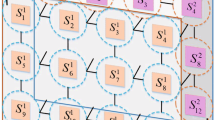Abstract
Often captured images are not focussed everywhere. Many applications of pattern recognition and computer vision require all parts of the image to be well-focussed. The all-in-focus image obtained, through the improved image fusion scheme, is useful for downstream tasks of image processing such as image enhancement, image segmentation, and edge detection. Mostly, fusion techniques have used feature-level information extracted from spatial or transform domain. In contrast, we have proposed a random forest (RF)-based novel scheme that has incorporated feature and decision levels information. In the proposed scheme, useful features are extracted from both spatial and transform domains. These features are used to train randomly generated trees of RF algorithm. The predicted information of trees is aggregated to construct more accurate decision map for fusion. Our proposed scheme has yielded better-fused image than the fused image produced by principal component analysis and Wavelet transform-based previous approaches that use simple feature-level information. Moreover, our approach has generated better-fused images than Support Vector Machine and Probabilistic Neural Network-based individual Machine Learning approaches. The performance of proposed scheme is evaluated using various qualitative and quantitative measures. The proposed scheme has reported 98.83, 97.29, 98.97, 97.78, and 98.14 % accuracy for standard images of Elaine, Barbara, Boat, Lena, and Cameraman, respectively. Further, this scheme has yielded 97.94, 98.84, 97.55, and 98.09 % accuracy for the real blurred images of Calendar, Leaf, Tree, and Lab, respectively.














Similar content being viewed by others
References
Mitianoudis N, Stathaki T (2007) Joint fusion and blind restoration for multiple image scenarios with missing data. Comput J 50(6):660–673
Susperregi L, Arruti A, Jauregi E, Sierrac B, Martínez-Otzetaa JM, Lazkanoc E, Ansuategui A (2013) Fusing multipleIimage transformations and a thermal sensor with Kinect to improve person detection ability. Eng Appl Artif Intell 26(8):1980–1991
Zhu H, Liu M, Ji H, Li Y (2010) Combined invariants to blur and rotation using Zernike moment descriptors. Pattern Anal Appl. doi:10.1007/s10044-009-0159-9:309-319
Dai X, Zhang H, Liu T, Shu H, Luo L (2014) Legendre moment invariants to blur and affine transformation and their use in image recognition. Pattern Anal Appl 17(2):311–326
Naidu VPS, Raol JR (2008) Pixel-level image fusion using wavelets and principal component analysis. Def Sci J 58(3):338–352
Hamzaa AB, Heb Y, Krimc H, Willskyd A (2005) A multiscale approach to pixel-level image fusion. Integr Comput Aided Eng 12:135–146
Burt PJ, Adelson EH (1983) The Laplacian pyramid as a compact image code. IEEE Trans Commun 31(4):532–540
Matsopoulos GK, Marshall S, Brunt JNH (1994) Multiresolution morphological fusion of MR and CT images of the human brain. IEE Proc Vision Image Signal Proc 141(3):137–142
Burt PJ, Kolczynski RJ (1993) Enhanced image capture through fusion. In: Fourth international conference on computer vision 1993, pp 173–182
Mumtaz A, Choi TS, Majid A, Mumtaz A (2010) Image fusion algorithm based on dual tree complex wavelet transform and support vector machine. In: International Bhurban conference on applied sciences & technology, Islamabad, Pakistan, pp 197–202
Lan Y, Ren H, Zhang Y (2013) Multi-band vector wavelet transformation based multi-focus image fusion algorithm. J Softw 8(1):208–217
Goodman TNT, Lee SL, Tang WS (1993) Wavelets in wandering subspaces. Trans Am Math Soc 338(2):639–654
Piella G (2003) A general framework for multiresolution image fusion: from pixels to regions. Inf Fusion 4:259–280
S-h Zhao, Xue-zhi F, Kang G-d, Ramadan E (2002) Multi-source remote sensing image fusion based on support vector machine. Chin Geogr Sci 12:244–248
Mamatha SG, Rahim SA, Raj CP (2012) Feature-level multi-focus image fusion using neural network and image enhancement. Global J Comput Sci Technol Graph Vis 12(10):16–23
Pagidimarry M, Babu KA (2011) An all approach for multi-focus image fusion using neural network. Int J Comput Sci Telecommun 2(8):23–29
Li S, Kwok JT, Wang Y (2002) Multifocus image fusion using artificial neural networks. Pattern Recogn Lett 23:985–997
Li S, Kwok JT, Wang Y (2004) Fusing images with multiple focuses using support vector machines. IEEE Trans Neural Netw 15(6):1555–1561
Wang X-Y, Zhang B-B, Yang H-Y (2012) Active SVM-based relevance feedback using multiple Classifiers ensemble and features reweighting. Eng Appl Artif Intell 26(2013):368–381
Ali S, Majid A, Khan A (2014) IDM-PhyChm-Ens: intelligent decision-making ensemble methodology for classification of human breast cancer using physicochemical properties of amino acids. Amino Acids 46(4):977–993
Breiman L (1996) Bagging predictors. Mach Learn 26:123–140
Breiman L (2001) Random forests. Mach Learn 45(1):5–32
Jiwu H, Shi YQ, Xianhua D (1999) A segmentation-based image coding algorithm using the features of human vision system. J Image Graph 4(5):400–404
Eskicioglu AM, Fisher PS (1993) Image quality measures and their performance. IEEE Trans Commun 43(12):2959–2965
Canny J (1986) A computational approach to edge detection. IEEE Trans Pattern Anal Mach Intell 8(6):679–698
Zhang Y, Ge L (2009) Efficient fusion scheme for multi-focus images by using blurring measure. Digit Signal Proc 19(2):186–193
Naidu VPS, Raol JR (2008) Pixel-level Image fusion using wavelets and principal component analysis. Defen Sci J 58(3):338–352
Klonus S, Ehlers M (2009) Performance of evaluation methods in image fusion. In: 12th International conference on information fusion, Seattle, WA, USA, July 6–9 2009
Heng C, LI Jie, Weile Z (2006) A novel support vector machine-based multifocus image fusion algorithm. In: International conference on communications, circuits and systems proceedings, 2006, pp 500–504
Acknowledgments
This research work is financially supported by the Higher Education Commission of Pakistan under the indigenous PhD scholarship No. 17-5-4(Ps4-101) HEC/Ind-Sch-2007.
Author information
Authors and Affiliations
Corresponding author
Rights and permissions
About this article
Cite this article
Kausar, N., Majid, A. Random forest-based scheme using feature and decision levels information for multi-focus image fusion. Pattern Anal Applic 19, 221–236 (2016). https://doi.org/10.1007/s10044-015-0448-4
Received:
Accepted:
Published:
Issue Date:
DOI: https://doi.org/10.1007/s10044-015-0448-4




